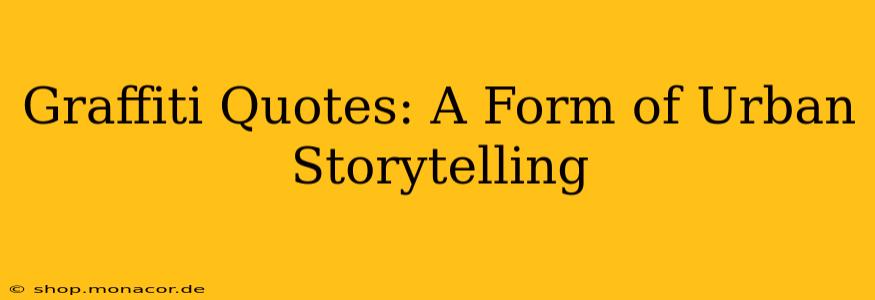Graffiti. The word itself evokes a range of responses, from disdain to admiration. Often viewed as vandalism, it's also a powerful form of self-expression, a vibrant visual language painting stories onto city walls. This article delves into the world of graffiti quotes, exploring their role as a unique form of urban storytelling, examining their meanings, motivations, and lasting impact. We’ll unravel the complexities of this controversial art form, showcasing its ability to communicate messages, spark conversations, and shape urban landscapes.
What Makes Graffiti Quotes Unique?
Unlike traditional forms of storytelling, graffiti quotes utilize the urban environment as their canvas. They're ephemeral, often appearing and disappearing quickly, adding an element of intrigue and urgency. This fleeting nature contributes to their power, making them feel raw, immediate, and intensely personal. The placement of the quote itself – on a bridge, a building, a forgotten alleyway – adds another layer of meaning, contextualizing the message within the surrounding environment.
Why Do People Create Graffiti Quotes?
The motivations behind creating graffiti quotes are diverse. For some, it's a means of political protest, a way to express dissent or challenge authority. Others use it as a form of personal expression, a way to share their thoughts, feelings, and experiences with a wider audience. It can also be a declaration of identity, a way of claiming space and belonging in a rapidly changing urban landscape. The artist might be seeking fame, recognition, or simply the thrill of the act itself.
What are the different styles of graffiti quotes?
Graffiti quotes manifest in various styles, reflecting the artist's skill and intended message. Some opt for simple, bold lettering, maximizing readability and impact. Others incorporate intricate designs, creating visually stunning pieces that demand closer examination. The choice of color, font, and background all contribute to the overall message, shaping how the audience interprets the quote.
Is graffiti art considered vandalism?
The legal status of graffiti is a complex issue. While often considered vandalism and punishable by law, the line between art and vandalism is frequently blurred. Many artists argue that their work enhances the urban landscape, bringing color, vitality, and thought-provoking messages to otherwise drab environments. The perception of graffiti often depends on the context, the content of the message, and the community's values.
What are some famous examples of graffiti quotes?
Several graffiti quotes have achieved iconic status, transcending their origins to become widely recognized symbols. These quotes often possess a powerful message that resonates with audiences on a deeper level, triggering conversations and debate. While I cannot provide specific examples due to the ever-changing nature of graffiti and the potential for misinterpretation, a simple Google image search will readily reveal many examples showcasing diverse styles and messages.
How does the location of a graffiti quote influence its meaning?
The placement of a graffiti quote dramatically influences its interpretation. A quote advocating for social justice painted on the wall of a government building carries a different weight and meaning than the same quote sprayed on an abandoned lot. The context of the location – its history, its symbolism, and its relationship to the community – all contribute to the overall impact of the quote.
The Lasting Impact of Graffiti Quotes
Graffiti quotes, while often temporary, can have a lasting impact. They spark conversations, challenge perspectives, and inspire further creative expression. They document the cultural climate of a specific time and place, serving as historical artifacts that reflect the experiences and sentiments of a particular community. The fleeting nature of these messages sometimes enhances their lasting impact – they are a reminder of the transient yet powerful nature of urban life and the constant evolution of our cities.
In conclusion, graffiti quotes are more than just words sprayed on a wall; they're a complex and dynamic form of urban storytelling. They are a testament to human creativity, a medium for expressing dissent, and a reflection of the evolving urban landscape. Their ability to spark dialogue, challenge norms, and leave a lasting mark on the city makes them a significant aspect of urban culture, deserving of further study and appreciation.

